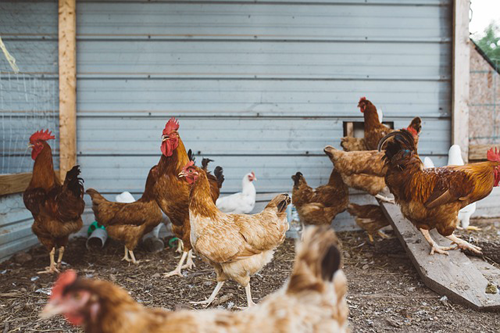Poultry is defined as live or dressed domestic birds, which are bred and reared for edible purpose and it includes chicken, duck, turkey and also quail, pheasant, geese, ostrich, guinea fowl, pigeon and dove. The domestic chicken (Gallus domesticus) has assumed a greater importance worldwide and accounts for more than 90% of the world’s poultry flocks.
Poultry is one of the fastest growing segments of the agricultural sector in many countries of the world including India. Currently, India is the second largest egg producer and third largest producer of broilers in the world. Adequate supply of minerals and vitamins in diet is the key for good poultry production. The feeding of vitamins and minerals deficient diet can produce numerous sheath problems for chicks including death in some cases.

Vitamin E
Vitamin E is a potent antioxidant and has an ability to modulate host immune functions. Vitamin E plays an important role in the differentiation of immature T cells in thymus. Vitamin E deficiency induces the decreased differentiation of immature T cells, which results in the early decrease of cellular immunity with aging in spontaneously hypertensive rats. Conversely, vitamin E supplementation induces a higher differentiation of immature T cells via increased positive selection by thymic epithelial cells, which results in the improvement of decreased cellular immunity in the aged.
Vitamin E has been shown to be essential for integrity and optimum function of reproductive, muscular, circulatory, nervous, and immune systems
Metabolism of vitamin E
Vitamin E is well recognized and accepted as nature’s most effective lipid-soluble, chain-breaking antioxidant, protecting cellular membranes from being attacked by lipid peroxyl radicals. It is actively absorbed in the gut: absorption depends on a number of factors but on average, achieves 42% expressed as α-tocopherol equivalents.
Vitamin E is packaged into lipid-bile micelles and is transported via the lymphatic pathway to the liver, where it is transiently stored. Vitamin E is deposited, in a dose-dependent way, in cellular and subcellular membranes (mitochondria, microsomes), which are rich in fatty acids and thus becomes an integral part of these structural elements, beneficially influencing the fluidity, the structural integrity and the functionality of biological membranes in all cells of the organism
Function in Poultry
- Antioxidant effect: Vitamin E functions as a membrane-bound antioxidant, trapping lipid peroxyl free radicals produced from unsaturated fatty acids under conditions of “oxidative stress.” Orientation of vitamin E within cell membranes appears to be critical to its functionality (Dunnett, 2003). It is well established that dietary supplementation of selenium, vitamin E, and carotenoids (Surai, 2002, 2018) can modulate antioxidant defenses in poultry. The antioxidant function of vitamin E is closely related to and synergistic with the role of selenium. Selenium has been found to be part of 25 selenoproteins with most of the functions unknown, although these selenoproteins generally participate in antioxidant and anabolic processes (Hatfield and Gladyshev, 2002). Selenium has been shown to act in aqueous cell media (cytosol and mitochondrial matrix) by destroying hydrogen peroxide and hydroperoxides via the enzyme glutathione peroxidase (GSH-Px), of which it is a co-factor.
- Membrane Structure and Prostaglandin Synthesis Alpha-tocopherol may be involved in the formation of structural components of biological membranes, thus exerting a unique influence on architecture of membrane phospholipids (Ullrey, 1981). It is reported that alpha-tocopherol stimulated the incorporation of 14C from linoleic acid into arachidonic acid in fibroblast phospholipids. Also, it was found that alpha-tocopherol exerted a pronounced stimulatory influence on formation of prostaglandin E from arachidonic acid, while a chemical antioxidant had no effect
- Immune response: The role of vitamin E for the functionality of the immune system has been extensively studied by several research groups and is based on the capability of vitamin E to prevent lipid peroxidation in membranes caused by lipid peroxyl radicals. Infectious diseases are an important factor in the production of free radicals for example as a consequence of macrophage function. Higher concentrations of d-tocopherol (50 and 100 mg per kg or 22.7 and 45.5 mg per lb) in feed reduced lipid peroxidation activity and enhanced activities of anti-oxidative enzymes and also improved cell-mediated immune response in commercial broilers (Ram Rao et al., 2011). Vitamin E at high supplementation levels has a strong immune response with enhance resistance of poultry to infectious diseases (Silva et al., 2009). Vitamin E affects both cellular and humoral immune function; T lympocytes were increased (Abdukalykova et al., 2008). Previously, Moriguchi and Muraga (2000) observed that vitamin E improved the immune system by enhancing host antiviral activity and the production of the antiviral cytokine interferon, which is produced by activated T cells.
- Meat quality: Lipid oxidation is one of the primary processes of quality deterioration in meat and meat products. The changes in quality are manifested by adverse changes in flavor, color, texture, and nutritive value and by the possible production of toxic compounds. Dietary supplementation of vitamin E above requirement levels has been found to be effective in reducing lipid oxidation in meat and meat products.
- Reproduction system: Vitamin E is necessary for the normal functioning of the reproductive system. There is evidence that the hormone regulation involved in the reproductive cycle of the birds is also involved in the metabolism of vitamin E. Supplementation of vitamin E above the minimum requirement improves ovulation during the last phase of the laying period, improving the bird’s defense system and averting negative consequences on egg production also in situations of environmental stress. Vitamin E protects against oxidation in sperm, egg yolk and embryonic tract. The supply of vitamin E in the ration should be continuous, as the hepatic reserve is insufficient to maintain an adequate vitamin concentration in all eggs, when laying rate is high. Inadequate vitamin E in the diet of breeders is detrimental to fertility, giving rise to the production of eggs with low hatchability and high embryonic mortality in the last phase of incubation due to failures related to the circulatory system.
- Organoleptic characteristics: Some studies have directly evaluated the effects of high levels of vitamin E on the sensory quality of meat using objective methods and/or panels of trained tasters. Vitamin E supplementation induced a lower drop in postmortem pH, which indicates a potential use in the prevention of pale, soft and exudative meat syndrome (PSE) a problem which is now more prevalent in turkeys than in broilers
Deficiency
Vitamin E deficiency in poultry can result in at least three conditions: exudative diathesis (Illus. 4-2) with signs of subcutaneous edema and, in severe cases, blackening of the affected parts, apathy and inappetence; encephalomalacia (crazy chick disease) (Illus. 4-3) characterized by ataxia, head retraction and cycling of legs; and muscular dystrophy (Illus. 4-4) (Scott et al., 1982).
Requirements
The NRC (1994) requirement for vitamin E for poultry species varies from 5 to 25 IU per kg (2.3 to 11.4 IU per lb) of diet. Growing and laying chickens have the lowest requirement at 5 IU per kg (2.3 IU per lb) while breeding turkeys and Japanese quail have the highest requirement at 25 IU per kg (11.4 IU per lb)
Sources
Corn, Corn gluten meal, Oats, Barley and Wheat contain significant amounts of alpha-tocopherol.






Be the first to comment